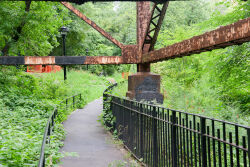West Farms Rapids
West Farms Rapids
The West Farms community is one of many historic settlements along the Bronx River—the only freshwater river in New York City. Measuring 23 miles, this blue corridor has been central to the life of the Bronx since pre-colonial days. It winds its way from the heights of Westchester County to meet the East River at Hunts Point.
Called Aquehung (River of High Bluffs) by the Lenape Indians who fished and hunted along its banks, the Bronx River derives its name from Jonas Bronck (1600-1643). The Swedish sea captain settled the mainland in 1639 as the Bronx's first European resident. Fur trading attracted early European settlers to the Bronx River valley and the local economy grew through the 1600s and 1700s. Farming and cottage industries developed and flourished until the Revolutionary War, when the river became a shifting battle line between American Patriots and British Loyalists until 1783.
Between the Revolutionary War and the War of 1812 and again in the 1840s during the construction of the New York & Harlem Railroad, factories sprang up along the Bronx River shores and harnessed the current to power manufacturing. These industries brought both prosperity and pollution as they dumped their refuse into the waterfront. In 1896, a report by the New York State Legislature stated that the river had become an “open sewer” and appointed a commission to remedy the problem.
After intensive study, the commission recommended that the city purchase the land alongside the waterway and transform it from an unregulated zone of farms, slums, and factories into a landscaped nature preserve. The Bronx River Parkway, America's first limited-access parkway, was thus born and allowed the city and state to control activity along the river and provide motorists, bicyclists, and pedestrians with a pleasant venue for recreation and scenic trips.
The original Bronx River Parkway protected the watershed as far south as Bronx Park. However, the Bronx River did not receive dedicated ecological restoration south of East 180th Street until 1974, when Ruth Anderberg founded the Bronx River Restoration Project (BXRR) on the inspiration of then Bronx Police Chief Anthony V. Bouza, who had already launched an intergovernmental dialogue to clean the river.
West Farms Rapids (formerly Bronx River Park, originally Restoration Park) marks the genesis of those efforts. The rubber-tire retaining walls commemorate when this place became a park in 1980. Around this time, BXRR also created the nearby Bronx River Art Center, River Garden, and published the Bronx River Restoration Master Plan. The plan advocated an ecological revival of the whole river with a continuous linear park from the Kensico Dam to its mouth at the East River—a concept which became the Bronx River Greenway.
Many hands contributed to these early efforts, including teenaged and adult workers and local community leaders. They were funded by city programs like Summer Youth Employment, Housing Preservation and Development (HPD), local elected officials, and Phipps Houses. Additional organizations dedicated resources for construction, programming, and maintenance. In the 1990s, local residents and workers formed a new coalition called the West Farms Friends of the Bronx River to revive this site. They organized riverfront cleanups, planted the original butterfly garden, and worked with NYC Parks to install picnic tables for family recreation.
In 1997, HPD gave the City jurisdiction over this park and by 2008 NYC Parks owned the property. Also in 1997, Partnerships for Parks convened the Bronx River Working Group, comprised of 20 founding partners, including Phipps Community Development Corporation, BXRR, and the Bronx Council for Environmental Quality. This collaboration culminated in 2001 with the creation of the Bronx River Alliance.
In 2008, this node of the Bronx River Greenway broke ground again to improve safety and enhance multi-modal access, featuring a canoe launch, a new butterfly garden, an amphitheater, and direct access to East Tremont Avenue. NYC Parks, the Bronx River Alliance, and community partners continue to maintain this beautiful and historic site.
Check out your park's Vital Signs
Clean & Safe
Green & Resilient
Empowered & Engaged Users
Share your feedback or learn more about how this park is part of a
Vital Park System










